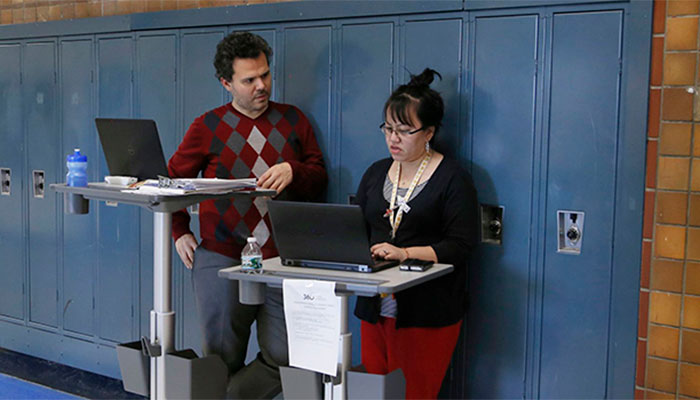Let’s face it—students spend most of their day sitting. Recess and physical education class only make up a small portion of the school day, and older students may not have these built-in periods for physical activity at all.
Using height-adjustable standing desks, students can reduce sedentary time and keep their bodies moving throughout the school day. Instead of sitting for most of the school day in fixed-height desks, students can alternate between sitting or standing throughout instructional time and respond to their own body’s needs.
Sit-stand desks can make a difference within the classroom for both students and teachers. But educators can also look beyond classroom walls for students to benefit from low-level physical activity (LLPA). Integrating regular standing across the school throughout the day is easy and creates a culture of movement through the entire school.
Here are a few ideas to get you started:
Media center
- Place sit-stand desks in formations of three or four in various corners of the media center or library for a quiet place for students to collaborate on group projects or assignments.
- Have spare sit-stand desks available for staff or students to use as a “shopping cart” or mobile desk. Students can file through the rows of books with the desk, look up a quick answer and add it to their notes, or place their picks on the desk instead of carrying a heavy load when bringing them to the check-out or their work area.
- Have standing height kiosks throughout the area for quick hit computer look-ups.
Physical education or health class
- Follow this recommendation from one physical education teacher in Seattle who uses standing desks during the instructional portion of her gym class. She has students simply roll them out of the way when the physical activity begins.
- Consider the same idea for health classes that often require students to sit on the floor or on bleachers if in a gym environment, since those spaces lack standard, stationary desks.
Cafeteria
- Give kids the chance to be more active during their unstructured times, like lunch breaks. Have spare units available and allow students to stand up as they eat or roll to different spots to create groups with their friends
Office
- Extend the benefit of LLPA to administration and support staff by making sit-stand desks available in individual administration offices, the nurse’s area or break rooms.
Hallway
- Improve accessibility to school leadership by equipping them with sit-stand desks as they make their rounds in the school. They can bring their laptop or tablet with them to check email, write notes, and do light administrative work in open locations like a hallway or the back of a classroom.
- Make the most of limited space by using sit-stand desks to conduct student or staff meetings in the hallway or other non-traditional areas.
- Give parents of younger school-age children a more comfortable space than miniature tables and chairs for parent-teacher conferences using standing desks.
Outside
 Think beyond the confines of the school building and take the mobile, sit-stand desks outside for students to benefit from the fresh air and sunshine. Students at Hialeah Gardens in Florida use their sit-stand desks to interact with farm animals in their agriscience class.
Think beyond the confines of the school building and take the mobile, sit-stand desks outside for students to benefit from the fresh air and sunshine. Students at Hialeah Gardens in Florida use their sit-stand desks to interact with farm animals in their agriscience class.- In warmer climates, students can take their desks with them from room to room like these fifth-graders at Emmanuel College in Queensland, Australia.
For more tips on how to transition to sit-stand student desks at your school, check out our start-up guide.



